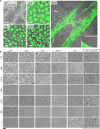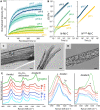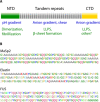Spider silk self-assembly via modular liquid-liquid phase separation and nanofibrillation
- PMID: 33148640
- PMCID: PMC7673682
- DOI: 10.1126/sciadv.abb6030
Spider silk self-assembly via modular liquid-liquid phase separation and nanofibrillation
Abstract
Spider silk fiber rapidly assembles from spidroin protein in soluble state via an incompletely understood mechanism. Here, we present an integrated model for silk formation that incorporates the effects of multiple chemical and physical gradients on the different spidroin functional domains. Central to the process is liquid-liquid phase separation (LLPS) that occurs in response to multivalent anions such as phosphate, mediated by the carboxyl-terminal and repetitive domains. Acidification coupled with LLPS triggers the swift self-assembly of nanofibril networks, facilitated by dimerization of the amino-terminal domain, and leads to a liquid-to-solid phase transition. Mechanical stress applied to the fibril structures yields macroscopic fibers with hierarchical organization and enriched for β-sheet conformations. Studies using native silk gland material corroborate our findings on spidroin phase separation. Our results suggest an intriguing parallel between silk assembly and other LLPS-mediated mechanisms, such as found in intracellular membraneless organelles and protein aggregation disorders.
Copyright © 2020 The Authors, some rights reserved; exclusive licensee American Association for the Advancement of Science. No claim to original U.S. Government Works. Distributed under a Creative Commons Attribution NonCommercial License 4.0 (CC BY-NC).
Figures






References
-
- Rising A., Johansson J., Toward spinning artificial spider silk. Nat. Chem. Biol. 11, 309–315 (2015). - PubMed
-
- Vollrath F., Knight D. P., Liquid crystalline spinning of spider silk. Nature 410, 541–548 (2001). - PubMed
-
- Heim M., Keerl D., Scheibel T., Spider silk: From soluble protein to extraordinary fiber. Angew. Chem. Int. Ed. Engl. 48, 3584–3596 (2009). - PubMed
-
- Yarger J. L., Cherry B. R., Van Der Vaart A., Uncovering the structure–function relationship in spider silk. Nat. Rev. Mater. 3, 1–11 (2018).

